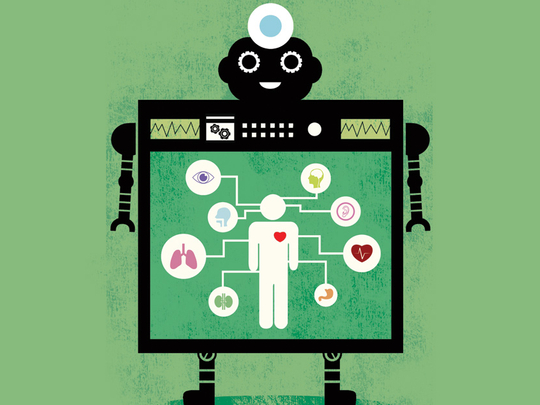
The GCC’s total health care expenditure is forecast to triple between 2011 and 2018, reaching $133.19 billion (Dh489.20 billion), according to a report by Frost & Sullivan.
Spending is projected to grow at a compounded annual growth rate (CAGR) of 10.3 per cent from 2010 to 2018 driven by the expanding population, higher incidence of lifestyle diseases, deeper insurance penetration, and a surge in medical tourism. The GCC is not alone.
Rising health care costs are well documented, with both the OECD and the World Bank showing its inexorable growth, both in terms of per capita and as a proportion of GDP. It is a perfect storm, and health services across the world must look for ways to reduce expenditure without negatively impacting the people who rely on them.
Technology promises to help reduce health care costs while enhancing quality of care. The ‘internet of things’ (or machine-to-machine (M2M)) has a crucial part to play in the technology mix and its sheer flexibility across the health care and wellness spectrum is part of its appeal.
M2M can be used in many health care applications from monitoring chronic conditions, through post-operative care, to consumer devices that encourage individuals to maintain generally good personal health standards and wellness.
For M2M to succeed in health care applications, the technology has to meet certain requirements. These include: excellent quality and reliable communications in both very local wireless and national and international cellular networks; small, robust and user-proof hardware; excellent battery life; reliable, secure data storage; speedy, meaningful big data analytics, and guaranteed data security.
Progress is being made on all these fronts, with vertical and horizontal alliances speeding the work along.
The Medical Body Area Network (MBAN) is a term used to define a wireless network of devices on or in the body. The BAN is applicable to areas other than health but has great application in this sector, which often relies on multiple information points to monitor a patient.
Body worn, and even ingested, sensors that are able to gather information and transmit it either to a hospital bed or further away have huge potential. The ability of such systems to trigger automatic actions, such as issuing alerts to contact a medical professional or even making such contact automatically have clear preventive health care uses.
One way to help reduce health care costs is to keep people living in their own homes for longer. Research carried out by Orange has shown that 73 per cent of senior citizens in Europe would feel more secure with a ‘teleassistance’ tool which could detect falls and call for help. M2M can be crucial here, with solutions such as motion detectors in chairs and beds able to send alerts after periods of non-movement — or movement.
We have only seen the very beginning of the rise of M2M in health care. ABI has predicted massive growth to more than 5 million disposable MBAN sensors shipping by 2018. And even this is a tiny fraction of the potential.
Machina Research has forecast a global installation of 847 million M2M connected health devices by 2023, generating revenues of $91 billion. North America will be the largest sector for M2M during this period with 386 million M2M devices in 2023.
This number spans the range of clinical remote monitoring, connected medical environments, personal health monitoring and improved assisted living monitoring. In a country such as the United States, with health care spending nearing 20 per cent of national GDP, M2M technology may well provide the single most promising approach to expanding health care services in a cost-effective manner.
New technologies are notoriously expensive, and tend only to be available to wealthy early adopters. It is only with mass market development and commoditisation that prices become competitive.
Collaboration in development can be crucial to price management. The GSM Association points out in a report, that the development of horizontal service platforms is crucial in “improving service delivery, reducing support costs and scaling the market”.
So, to promote success in the M2M health sector, alliances need to be both broad and deep. Operator alliances across geographies are as important as hardware and data provider alliances.
Apple’s HealthKit is centred on a data hub accessible to both individuals and health care professionals.
Open systems can also help accelerate development. Samsung’s recent announcement of its Simband sensor and SAMI open data platform along with the opening of its Digital Health Innovation Lab at University of California, San Francisco, is a very public statement from a major mobile technology player that it believes in the future of M2M and wishes to help speed it along.
Data security will be a key challenge for providers. Data breaches quite rightly get huge media coverage.
Both health providers and consumers will need to be 100 per cent confident that medical data is secure. Unfortunately, security breaches in areas like online shopping and banking could tarnish the M2M health solutions sector by association.
Personal data is personal data, after all, and people are right to be cautious. To meet their potential, M2M health care services must start — and continue to develop — without suffering data breaches.
This requires security solutions which are more complex than those traditionally used in business. They need to ensure that all nodes in what could be a complex, multi-device system are secure and technical standards are met. In addition, national data protection legislation needs to cover M2M and health care provider policies need to encompass it.
There are many hurdles for the nascent M2M health sector to overcome. And it will overcome them.
Demands on health services are simply not sustainable at current levels, and through sheer necessity traditional models of health care need to be revised and reinvented. As the benefits become apparent health care providers and patients will both reap the rewards.
The writer is Managing Director of Orange Business Arabia.












